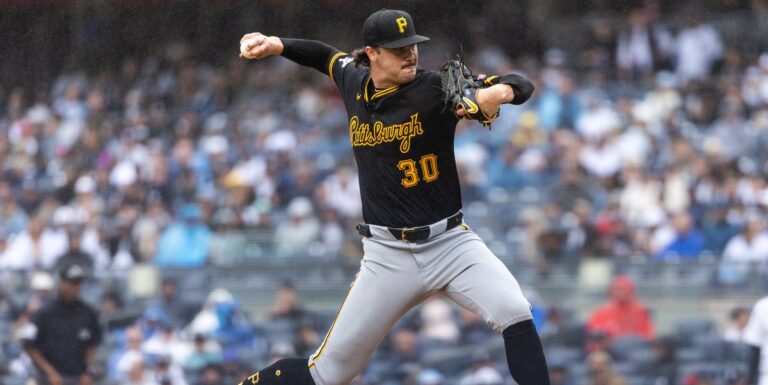IF THERE’S ONE thing National League batters should fear this year, it’s the fact that Paul Skenes, the 2024 NL Rookie of the Year, didn’t slow down at all during the off-season.
Skenes threw a 101.9 mph fastball in his MLB debut on May 11, 2024 and kept throwing hard and fast throughout the season, with a four-seam fastball average hovering around 98 mph. The Pirates ace was one of the best starting pitchers in all of MLB in his first year, finishing 11-3 with a 1.96 ERA in 23 starts and setting numerous records, including an ERA that led all MLB rookies (minimum 100 innings pitched). He was the first rookie pitcher to record at least 170 strikeouts and a sub-2 ERA since earned runs became official in 1913.
That success comes from intense preparation, and a regimen that looks like nothing else you’ve ever seen on the diamond. The 6’6” righty’s warmup routine went viral last season, with his use of unorthodox tools and funky-looking rotational moves, but that’s just a small part of prep work he’s put in en route to mastering the position, with a rare combination of velocity and command as he enters his sophomore season in the big leagues.
We talked to Skenes about that warmup routine–footballs and water bags, anyone?—being one of three young stars featured on the cover of MLB The Show 25, and the one move he loves in the weight room.
MH: Let’s start with your warmup routine. You utilize different equipment throughout, including some unconventional tools. What are you specifically honing in or working on through each step?
PAUL SKENES: I’ll start with the overhead band. It activates the lats and the obliques, which is important and keeps me tall. I haven’t done that [exercise] in a while, but it was something I added over the summer last year. It activates the lats and obliques in a different way, which you need to rotate. It helps you accelerate and it helps you stop.
The blue water bag activates the obliques in a different way in that it stresses them. So it’s very good for building volume in the off season. The reps that I do toward the end of the season are more just touching it versus getting my body primed for volume during the season. So during the off season, we’ll do a lot more reps than we will during the season. The instability with the water helps me feel my sequencing. It helps me feel my chest go this way and then finish that way.
The football is a 15- or 16-ounce ball. We throw plyo balls. I don’t know the exact science on plyo balls because I throw a 15-ounce plyo ball and a baseball is five ounces—I don’t know if throwing a 15-ounce plyo ball is equivalent to throwing three baseball throws, if that makes sense. But I know that we need to do it because of sequencing, building up volume. The football is essentially throwing a 15-ounce plyo ball just with a different arm action, different stimulus, just being athletic.
Pitchers get pigeonholed a little bit sometimes because they do the same thing every pitch, versus quarterbacks who are on the run, they’re throwing to different places, different distances, stuff like that. Shortstops are throwing on the run from different angles. So this keeps us athletic.
MH: You are someone who is pretty innovative with pitching. Whether you’re adding new pitches in the offseason or honing what you have, how do you train specifically for example, velocity?
PS: [Velocity] is not something that I’m changing or chasing anymore because I have it, and because my body knows how to do it. So weightlifting stuff, the water bags, the band, that all plays into it because at the end of the day, moving well comes first. The velocity is generally a byproduct of that. But if you’re not moving well and you’re throwing hard, that’s a good way to get hurt. And if you’re moving well and you’re not throwing hard, that’s probably a little bit less of a way to get hurt, but that’s a good way to get hurt too.
So the main thing is training, moving well—basically moving efficiently. In the weight room movement prep, the focus is to move well. And then having a good strength base to withstand 200-plus innings, hopefully it all ties together. Having a good strength base probably leads to higher velocities if we’re just looking at velocities, because it gets you stronger and it gets you moving better, and it also leads to better stamina over the course of a season.
MH: Did you figure that out that having a strong strength base can help lead to high performance in college or even before?
PS: The main difference when I got to college versus high school was that I grew a little when I got to college. If you look at me when I transferred out of the Air Force my sophomore year to when I finished up at LSU my junior year, it was like boy versus man. I got a lot stronger. There was probably about 20 pounds of difference.
And then going out there and actually being in it and doing it teaches you that, too. But you can’t do it in pro ball unless you have the strength base and you’re moving well and all these different things. I haven’t figured it out by any means—I’m still constantly learning, constantly evolving. My routine now is not going to be what I do in a year, or two years, because we’re always learning and we’re always trying to figure out new ways to help my body and to get better.
MH: Do you like strength training? Do you like the weight room?
PS: On some days. Occasionally I don’t like it—but I like to think of it as we are professional weightlifters who throw baseballs, because my warmup routine is effectively a lift. On four out of five days, I’m going out there and I’m throwing a ball for 10 minutes and then I’m done and then I lift some more. I do my movement prep and then I throw for 10 minutes, 15 minutes, and then I lift some more. On a start day, that’s when we actually do our job.
I don’t love [the weight room]. It’s very monotonous, especially during the season. But you don’t have to love the work. You just have to love the results.
MH: Do you have one exercise you like in the weight room?
PS: I do split squats every rotation, and I do split squats pretty much throughout the whole offseason too, either with a safety bar on my back or holding dumbbells or kettlebells. That’s the one I probably enjoy the most because it stays constant throughout the year. The routine itself stays the same, but the exercises are switched out very frequently, and there are a lot of supplemental lifts that become very monotonous. So I don’t always enjoy them. But again, it takes what it takes. Safety bar split squat is probably my favorite because we’re moving the weight and we’re measuring how fast we’re moving the weight. There are very definable statistics that show you’re either getting stronger or you’re recovering better or whatever it is that is making you move the bar quicker. Doing it with kettlebells is fun too.
MH: What does your recovery look like on the days you are starting and throwing a lot of pitches?
PS: That’s the biggest thing we found a couple years ago, that my central nervous system does not start to recover until 24 hours afterward. I could do some hot and cold tub and get some blood flowing, which might speed it up a little bit. But in terms of arm care, bands, weights and stuff like that, we found that with my body and my physiology, it doesn’t do a lot of good to add any volume, add any load to my body after throwing a hundred pitches.
MH: Is there anything you learned in your first professional season last year that you’ve adopted into your routine or larger approach to the game?
PS: The biggest thing that I learned is that any change that I make, mechanically, there’s a two week or a two start/two rotation delay. We had done an assessment three or four days before my debut and we found that my T-spine [thoracic spine] mobility was super low. So we had to make a mechanical adjustment to artificially create T-spine mobility. While we’re doing that in the weight room, we’re trying to build T-spine mobility. So the time that I could not cue this T-spine move of this extra counter-rotation was two starts after that when I just naturally had it in me. By August, I started feeling it a little bit, and then I started getting into hot and cold tubs every day. It’s like clockwork because two starts after that is when I started really feeling good. So it takes a lot of patience.
MH: Let’s talk about MLB The Show. How does it feel to be one of the cover athletes?
PS: It’s awesome. Gunner and Elly are really good players. I’ve played against Elly and he’s given me some trouble. Gunner I have not faced each other yet, but to be honest, I probably will this weekend. They’re great baseball players, extremely talented. I’ve met both of them before, spent time with them, and from what I can tell, they’re even better people. So it’s pretty cool to have that connection. To even be in the conversation with them is amazing. It’s kind of immortalized now to be on the cover of The Show and that’s a huge honor.
MH: Are you a video game guy? Were you already a player?
PS: I’m not. I played a little bit. The last one I probably played was 2016 or something at my buddy’s house. But I never had a PlayStation, I never had an Xbox or anything. I’ve tried to get into video games and it’s not my thing. So maybe I’ll try playing it, who knows?
MH: Is there anything you’re particularly looking forward to excited about either with the Pirates or in your second major league season coming up?
PS: Just continuing to learn. I think it’s even harder to be good in your sophomore season than your rookie season. I would imagine that it’s harder to be good in your third season than your second. I think every year it gets harder, and that’s a unique challenge, but it’s also a unique opportunity. So having the opportunity to be better than I was last year, it’s going to be fun.

Anna Katherine Clemmons is an adjunct professor of Media Studies at the University of Virginia, and has written for numerous publications, including ESPN the Magazine and The New York Times.
Read the full article here


